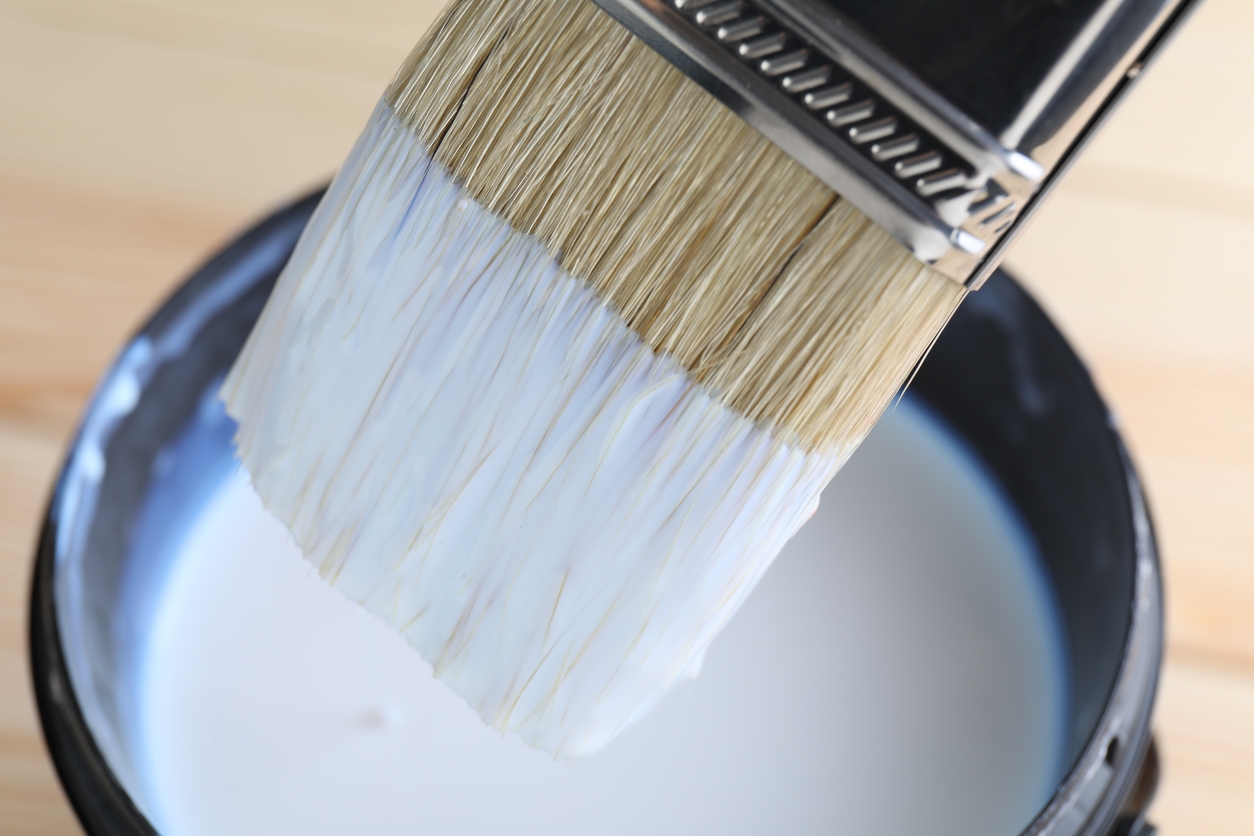Streaks are one of any painter’s pet peeves. In apartments, common painting issues often include paint streaks, uneven coverage, and drips, with streaky walls being one of the most frequent problems. You may also need an experienced team handles stubborn adhesive and old paper quickly – find out more about our wallpaper removal process.
These streaks can significantly diminish the aesthetic appeal of a freshly painted space, leaving walls looking unprofessional and unfinished. Achieving a smooth, even finish requires proper preparation, including cleaning and priming surfaces, as well as using the right tools and techniques. Careful application, maintaining consistent pressure, and using quality brushes or rollers are crucial to avoiding streaks and ensuring a polished, professional look.
Understanding why paint streaks happen
Understanding why paint streaks happen involves several factors:
- Uneven application: Using the wrong brush or roller or applying too much or too little paint can cause streaks. A roller with the wrong nap for the surface can result in uneven coverage.
- Poor quality paint: Low-quality or old paint lacks good flow and leveling properties, leading to streaks during application. Investing in high-quality paint can reduce this issue.
- Incorrect technique: Improper rolling or brushing techniques, such as applying too much pressure or not overlapping strokes evenly, can leave visible streaks.
- Insufficient prep work: Painting over dirty, dusty, or uneven surfaces prevents the paint from adhering smoothly, resulting in a streaky finish.
- Environmental factors: High humidity, extreme temperatures, or rapid drying conditions can cause paint to dry unevenly, increasing the likelihood of streaks.
Proper surface preparation
Proper surface preparation prevents paint streaks and ensures a smooth, long-lasting finish. Here’s a detailed breakdown of each step:
1. Cleaning the walls
Removing dust, dirt, and grease from the walls is essential before painting. Any residue can interfere with paint adhesion, leading to uneven application and streaks. Use a mild detergent and water, and rinse thoroughly to ensure a clean surface for optimal paint performance.
2. Sanding the surface
Sanding down rough areas or previous paint layers smooths the surface, allowing for better paint adhesion and a uniform finish. It helps eliminate imperfections that could cause streaking and creates a texture that promotes even paint application. Use fine-grit sandpaper for best results.
3. Using a primer
Applying a primer is vital, especially when transitioning from darker colors or when repairing specific areas. Primer creates an even base, enhancing paint adhesion and color accuracy. It also helps hide imperfections and reduces the number of paint coats needed, minimizing the risk of streaks.
4. Filling and smoothing imperfections
Filling holes, cracks, and other imperfections with a spackling compound is essential for achieving a smooth surface. After filling, sand the areas until they are flush with the wall. This ensures the paint goes on evenly and prevents visible lines or streaks from showing through the finished coat.
Choosing the right tools
When selecting the right tools for painting, here’s what to consider:
- Rollers and brushes: Select the roller nap based on the wall texture. For smooth walls, a shorter nap (¼” to ⅜”) works best, providing a sleek finish. For textured surfaces like popcorn or stucco, use a thicker nap (¾” or higher) to cover uneven areas effectively.
- High-quality brushes: Investing in quality brushes ensures smoother application and helps avoid visible brush streaks. High-quality brushes hold more paint and release it evenly, reducing the need for multiple strokes.
- Paint trays and grids: Use paint trays with grids to load paint evenly onto the roller. Roll the roller back and forth on the grid to remove excess paint and ensure smooth, consistent layers without over-application or drips.
Using the right paint for apartments
When painting apartments, especially when aiming for a smooth, streak-free finish, the following factors come into play:
Paint quality
Higher-quality paints typically contain better pigments and resins, which enhance their flow and leveling properties. They spread more evenly over surfaces and are less likely to show brush or roller marks. Investing in premium paint can make a significant difference in achieving a smooth finish, reducing the need for additional coats and touch-ups.
Choosing the right finish
The finish of the paint plays a crucial role in its appearance.
- Matte finishes are great for hiding imperfections but can show streaks if not applied carefully.
- Satin finishes offer a bit more sheen and are more forgiving, providing a smooth look without being overly shiny.
- Semi-gloss finishes are the most reflective, making them excellent for areas that require durability (like kitchens and bathrooms). However, they can also accentuate imperfections if the surface isn’t properly prepared.
Choosing the right finish helps mitigate the appearance of streaks based on the room’s function and lighting.
Consistency of the paint
Proper paint consistency is vital for achieving even coverage. Stir the paint thoroughly before use to ensure you distribute pigments and additives evenly. If the paint seems too thick, consider thinning it with an appropriate solvent (like water for latex paints) following the manufacturer’s recommendations. Doing so helps the paint flow better and reduces the likelihood of uneven coverage, which can lead to streaks.
These factors can help you achieve a beautiful, streak-free finish in your apartment painting projects.
Applying paint properly to prevent streaks
Here’s an overview of the key techniques for applying paint properly to prevent streaks:
1. Cutting in first
Cutting in involves using a brush to paint along the edges, corners, and around trim before rolling out the larger wall areas. This step is essential as it allows you to achieve clean lines and ensures the roller can reach all edges without overlapping with the adjacent surfaces.
2. Rolling techniques
When using a roller, apply the paint using a “W” or “M” pattern. This technique helps distribute the paint evenly across the wall. Start at the top and work your way down, overlapping each stroke slightly to prevent lines or streaks.
3. Maintaining a wet edge
Maintaining a wet edge is crucial to avoid visible streaks where wet paint meets dry paint. Always work in manageable sections, ensuring that the edges of damp paint overlap with the freshly rolled areas before they dry.
4. Thin, even coats
Applying thin and even coats of paint rather than one thick coat is crucial to reducing the chance of streaks. Thin layers dry faster and adhere better, resulting in a smoother finish. It’s generally better to apply multiple thin coats, allowing adequate drying time between each.
5. Avoiding overworking the paint
Avoid going over the same area too many times with the brush or roller, as this can lead to streaking. Once you’ve applied paint, allow it to set and dry before touching it again. If you need to adjust or touch up an area, do so sparingly.
Fixing paint streaks after application
Fixing paint streaks after application is essential for achieving a smooth, professional finish. Here’s a brief guide on how to identify and correct them:
Identifying streaks
- Examine under different lighting: Streaks can be more visible in certain lighting conditions, such as bright daylight or direct artificial light. Check the painted surface at different times of day and under various light sources to identify any inconsistencies.
- Angle your view: Stand at different angles to the wall to spot streaks that may not be apparent from a straight-on view.
Sanding and repainting
- Lightly sand streaky areas: Once you have identified the streaks, use fine-grit sandpaper (220-grit or higher) to sand the affected areas lightly. Be gentle to avoid damaging the underlying paint layer.
- Clean the surface: After sanding, wipe the area with a damp cloth to remove dust and debris.
- Repaint with an even coat: Apply a thin and even coat of paint over the sanded area using a high-quality brush or roller. Avoid overloading the brush to minimize the risk of streaks.
Feathering the edges
- Use a dry brush technique: When repainting, use a dry brush or roller to feather the edges of the repair area. Start from the repaired section and gradually move outward, using less paint as you approach the surrounding area.
- Blend with light strokes: Make sure to use light, smooth strokes to blend the new paint into the existing paint, helping to create a seamless transition between the areas.
Avoiding common mistakes that lead to streaks
Avoiding common mistakes is crucial for achieving a smooth paint finish without streaks. Here’s a brief overview of key points:
- Not letting the paint dry fully between coats: Wait for the first coat to dry completely before applying a second coat. Applying a second layer too soon can disturb the first coat, leading to uneven coverage and streaks.
- Using poor-quality equipment: Low-quality rollers and brushes can significantly affect the finish. They may shed bristles or fail to hold enough paint, resulting in inconsistent application and visible streaks. Investing in good-quality tools ensures a smoother finish.
- Painting in poor conditions: Avoid painting in extreme humidity or heat. These conditions can cause the paint to dry too quickly, preventing it from leveling correctly and leading to streaks. Aim for moderate temperatures and humidity levels for optimal results.
Preventative maintenance for streak-free walls
- Proper wall care: To keep painted walls smooth and free from streaks, perform regular maintenance by gently cleaning with a soft cloth or sponge. Use a mild soap solution to avoid damaging the paint, and wipe away dust and grime regularly to prevent buildup.
- Touch-up techniques: For minor blemishes, use a small brush to apply touch-up paint, carefully blending it into the surrounding area. Feather the edges by dabbing gently to ensure a seamless transition, and always match the paint finish and color for the best results.
The importance of hiring a professional painter
Hiring a professional painter is crucial for achieving high-quality results and a lasting finish. Experienced painters utilize advanced techniques to ensure streak-free results, drawing on years of practice to master application methods and surface preparation.
Professionals possess an in-depth understanding of various paint types, finishes, and surfaces, enabling them to choose the best materials for each project. This knowledge helps to prevent common issues like peeling or bubbling, ensuring a durable and aesthetically pleasing finish.
Moreover, professional painters use specialized tools and high-quality products that minimize mistakes often made in apartment settings, such as drips, uneven coverage, or paint splatter. Their expertise leads to a smoother, more efficient process, ultimately saving time and money while delivering exceptional results.
Conclusion
Proper preparation, using quality tools, applying the paint in the correct techniques, and choosing the right paint is essential to achieving a streak-free paint finish on your apartment walls. Serving the Bay area including the cities of Pleasanton, San Ramon, Santa Clara, Sunnyvale and Sunol.
But if you want a flawless and professional-looking finish for your apartment walls, contact Custom Painting, Inc. Call us today at 925-294-8062 or message us on our contact page, and let us handle your next painting project!



